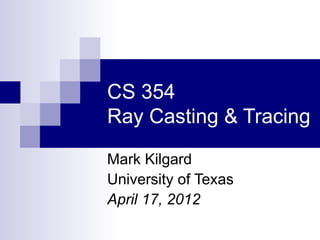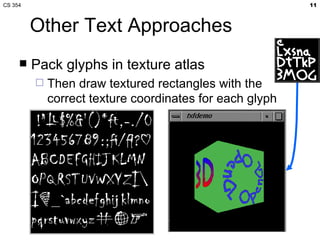This document summarizes a lecture on ray casting and tracing in the CS 354 course. It discusses ray casting, an in-class quiz on typography, the professor's office hours, details on Project 3 which involves animating a stick figure from motion capture data, and an overview of ray tracing techniques including reflections and limitations of OpenGL for realistic rendering.







![CS 354 8
Massively Parallel GPU-accelerated
Path Rendering Visualized
Anchored triangle Anchored triangle
fans geometry fans net stencil
Stencil =1
Path commands
and control points Resulting net
coverage in stencil
Curved segment Curved segment
geometry net stencil
Stencil -1
Stencil +1
Credit: [Kokoji 2006]](https://image.slidesharecdn.com/24raytrace-120418174018-phpapp02/85/CS-354-Ray-Casting-Tracing-8-320.jpg)








































![CS 354 49
Real-time Ray Tracing
GPUs doing ray tracing
General purpose compute on GPUs
[Optix, NVIDIA, SIGGRAPH 2009]](https://image.slidesharecdn.com/24raytrace-120418174018-phpapp02/85/CS-354-Ray-Casting-Tracing-49-320.jpg)







